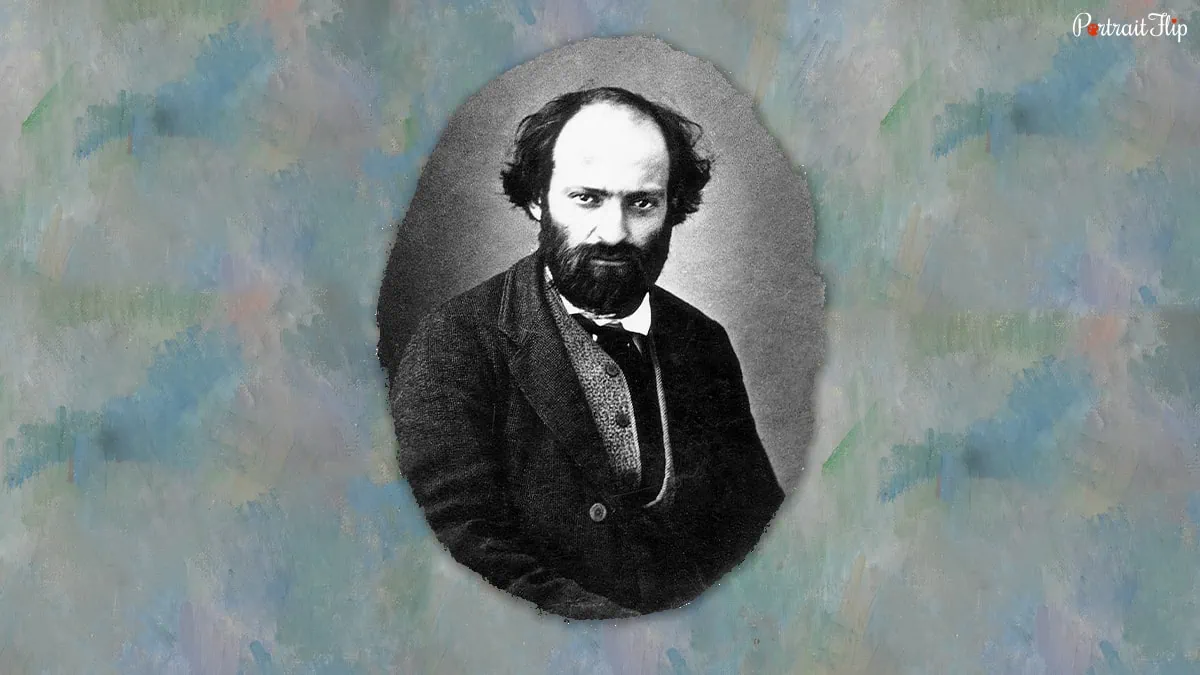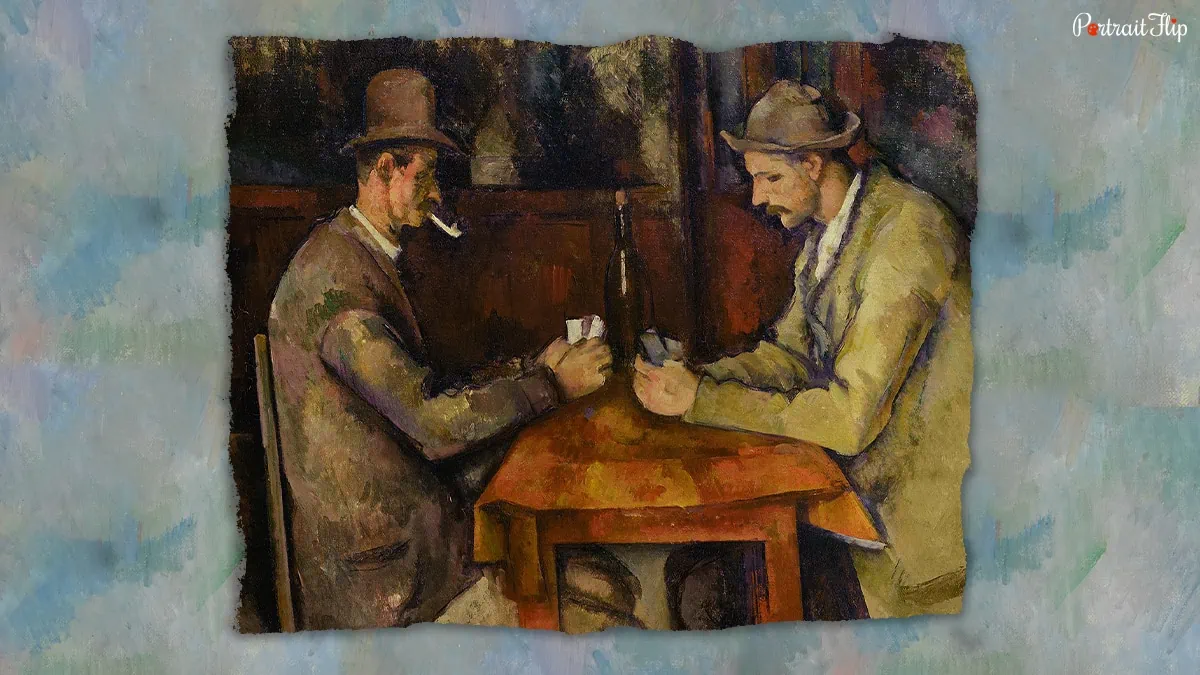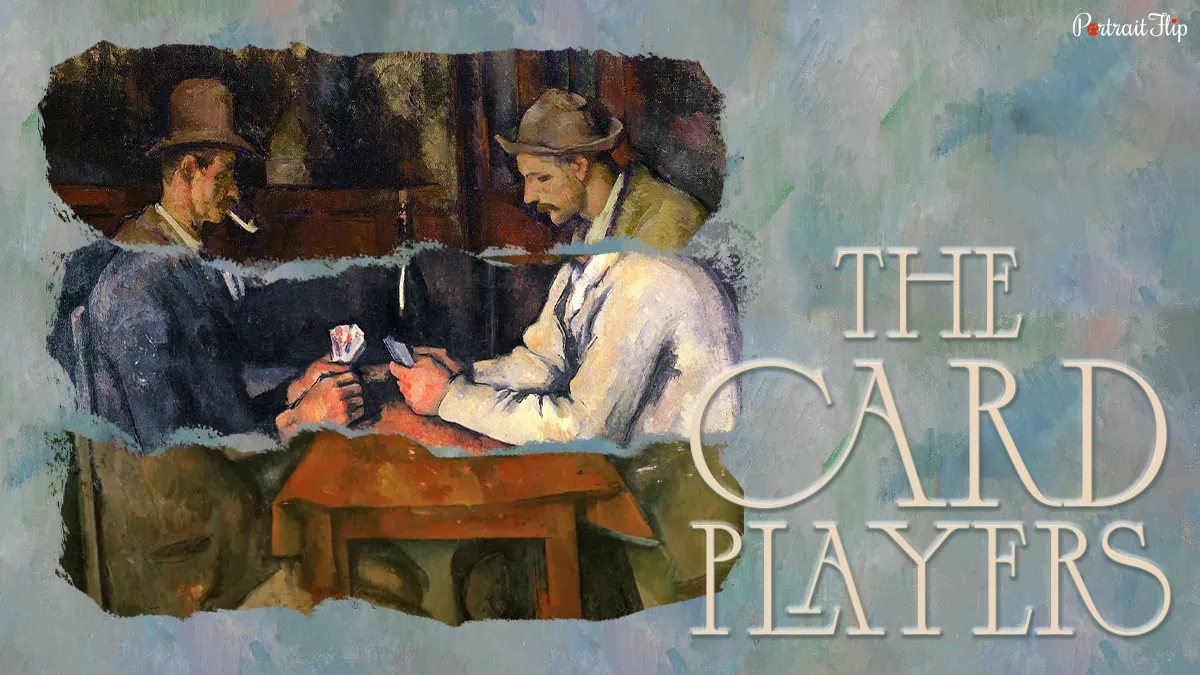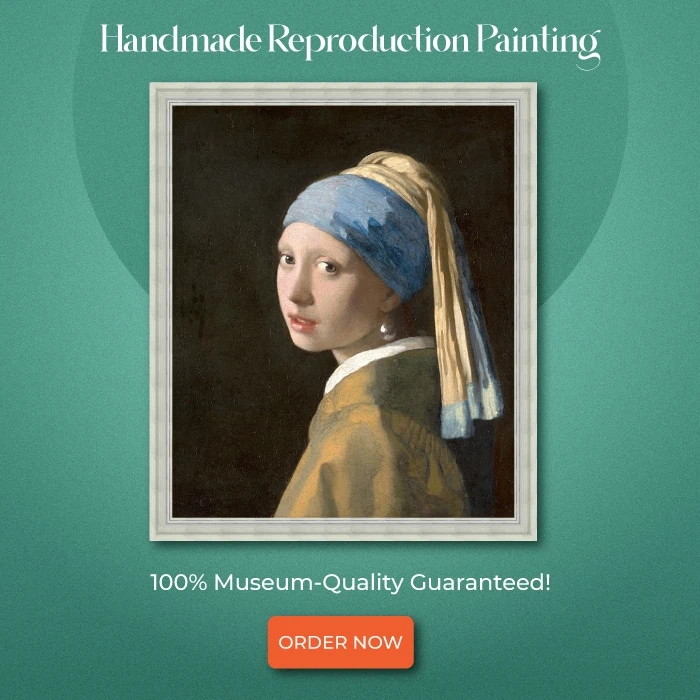How do you describe art?
It can be described by keeping a few things in mind, such as the painter’s point of view, the period in which the art was created, or the circumstances that led to its creation.
The three aforementioned factors give art a largely novel vision that is admired by viewers.
Each piece is unique, but what if I told you that there are various versions of some renowned artworks as well?
Yes, you read it right. Not replicas, but versions!
The Card Players by Paul Cézanne is one of the paintings that is exhibited in five different versions.
Are you inquisitive to know more about it? Keep reading further, where we talk about the painting “The Card Players” in detail.
Table of contents
1. The Post-Impressionist Artist

A French artist, Paul Cézanne (1839–1906), was exposed to the city’s art life and style during his stay near the countryside.
He visited Paris, which enhanced his artistic nature and love for the art culture.
Claude Monet, Edouard Manet, and others primarily influenced Paul with their works.
His primary works belong to the still life paintings, landscape artworks, and portrait genres, which revolve around subjects like fruits and human figures.
Paul also amplified his knowledge of classical arts at the Louvre and found his own unique style.
The artist’s curious mind and impeccable skills made him one of the founding fathers of post-impressionism.
Being a prolific artist, Paul created more than 900 oil paintings and 400 watercolor paintings.
Now that you know about the artist, it’s time to acknowledge the art that made him count among the most famous French artists.
2. Historical Overview of the Art
Versions: All Five
Genre: genre painting
Medium: oil on canvas
Which is the first Card Player painting?
Let me give you the answer: The Card Players (1890–1892), which is on exhibition at the Barnes Foundation, was the first painting by Paul Cezanne.
It basically depicts the life of Provençal peasants who are immersed in their playing cards and smoking pipes.
Paul Cezanne created all five versions in different sizes.
The number of characters also varies according to the painting, with male figures being the constant subjects.
All the male characters are studious and indulgent in the game, with some drunken and rowdy appearances.
In 1890s, during the last days of Cezanne’s career, he created such remarkable arts.
But the question that crosses the mind of the viewers is what made Paul paint such an artwork?
Want to know the answer? Keep reading…
3. What Inspired Paul to Paint “The Card Players”?
Inspiration is a feeling that makes a person produce the most incredible works of their lives.
Caravaggio’s paintings and Chardin’s works inspired Paul Cezanne, which made him choose the subject for his final paintings.
He undertook a painting campaign in which he devoted himself to the form that is shown in the artwork “The Card Players.”
The Card Players paintings are inspired by 17th-century arts and city cafes.
The subject matter depicted in the painting was a common tradition during the 17th century that has been in culture for ages.
Paul Cezanne showcases the artist’s playing cards, influenced by the Le Nain brothers‘ paintings, in the first two versions.
His Thesis and Beliefs
Paul was a conservative person who remained the same despite knowing that change is a constant part of life.
He has a belief that his age belongs to the period that makes him observe his past by staying where his origins are.
In his painting, he gives a symbolic representation of the inherited world.
The artist playing cards was a thought that showcased the livelihood of the local people in the town. The painter Paul Cezanne already had an image of the card players.
He was determined from the beginning about what the Provencal scene would look like.
Local farmhands, pipes within four walls, and some gambling were the main focus of the painting.
Each famous artist has their own beliefs, which give them a unique character and make them produce masterpieces that are marked in the history of art.
Have you seen all of The Card Players versions by Paul? No, right?
Have a glimpse of all the versions that will give you a clear picture of the painting and the concept of Paul Cezanne.
4. Versions of the Art
As we know, The Card Players has five versions in total. The subjects in all the versions are the same—male figures, cards, and postures.
But what makes them different? Well, observe them from your own perspective in the order they were painted.
a) The Barnes Foundation, Philadelphia, Pennsylvania

1st version (1890-1892); Image: upload.wikimedia.org
b) The MET, New York

2nd version (1890-1892); Image: metmuseum.org
c) Private Collection

3rd version (1892-1893); Image: upload.wikimedia.org
d) The Courtauld Institute of Art, London

4th version (1892-1895); Image: upload.wikimedia.org
e) The Musee d’Orsay, Paris

5th version (1894-1895); Image: upload.wikimedia.org
Paul Cezanne, as an artist, produced five paintings under the same title, which marked a milestone in the history of art!
5. The Visual Description
The visual description speaks about the perspective of the artist.
The frame, the character, the background, and the arrangements of the subjects convey the painter’s outlook.
In the first two versions, we spot a person standing to the left who’s watching the card game and the players.
Cowboy hats, coats, and the look on their faces give the impression of how serious the game must be.
If you give a closer look at the playing card art, each art depicts the cards being kept adjacent to the players.
The man standing had the pipe in his mouth, whereas the other three players were not smoking during the game.
The composition also appears calm, and the art seems to be overly animated and reserved, with a concentration on the game.
The other card players’ paintings by Paul Cezanne depict a darker appearance.
Paul wanted to make the viewers focus on the main characters while understanding their lives and how important this card game is.
If we observe, the painting gives out the significance of what a card game is for people in real life.
With different versions, there are numerous interpretations, but the only thing that does not change is the men playing cards with pipes!
6. Who are the players?

The players of the painting; Image: wikipedia
A common question that stays in the minds of the public is, “Who are the players in the painting “The Card Players?”
Are they real people? Or are they masters of the game?
Well, they are the local peasants who modeled for Paul Cezanne’s artwork.
Some of the names were reportedly mentioned after the painting, including Paulin Paulet, who was believed to be a gardener working for the Cezanne family.
Paul Cezanne was said to have had the portrait made in his farmhouse, where he admired the local people and wanted to give their faces meaning.
As earlier mentioned, the painting that exhibits in the MET Museum depicts the Le Nain brothers, namely Antoine, Louis, and Mathieu (left to right).
For Paul, players’ cards were the second thought; the primary aim was to study the local peasants, giving a name to them.
Paul Cezanne’s paintings are always influenced by the people around him, which eventually led to the creation of The Card Players.
The idea was to give the art a touch of reality and authenticity, which could be successfully examined through this painting.
7. Symbols and Metaphor
Being one of the post-impressionist artists, symbolism and metaphor are inevitable in a painting.
Paintings by Cezanne provide the viewer with art that is full of symbolism and questions about the human figures shown.
The Card Players is a famous impressionist painting that can’t be described without an allegory.
From the first version to the last, the difference we observe is in the number of male figures, which reduces gradually, and their facial expressions.
The man standing with folded hands represents the father figure of the game, or we could simply say the master.
He is a symbol of affirmation and power through the mastery of cards.
The portrayal of the father figure is believed to be a symbol of the artist’s relationship with his father.
If you observe the painting, the subject, which is “the cards,” portrays a strong message.
It represents nobility and majesty, which were known in ancient times.
People used to gamble in order to showcase their wealth and prosperity.
Another metaphorical representation shown in the painting is uncomfortableness or primitiveness.
The depiction of such modern art during Paul’s era was not much appreciated.
The playing of cards was compared to the primitivism of the painting.
With different versions, the symbol and metaphor vary accordingly.
8. The Cezanian Method

Famous paintings by Paul Cezanne, The Basket of Apples, Pyramind of Skulls, The Card Players; Image: wikipedia
What is the Cezanian method?
The Cezanina term derives from Paul’s surname, which literally means the introduction to the technique by Paul Cezanne.
Now that you have examined Paul’s work in different forms, we can further talk about the Cezanian method, which provides a perspective on the painting in the way it is shown.
Throughout the series of The Card Players, he has aimed to switch figures.
His methods of experimenting with the shades and presenting a chromatic appearance in the paintings were his primary objectives.
Impressionist art that portrays durability was Paul’s primary target.
The Card Players was one of Paul’s most tricky work, in which he used simple shades to illustrate the painting that smells like a museum piece.
The last three versions were the most accomplished due to the rigorous construction, with the dark shades illuminating an energetic feel.
In the series of paintings made, you could notice that the background was covered in darkness.
Did you notice a bottle of wine in the last three series? There is a resemblance to a wine bottle that serves as a division between the players.
These small details made Cezanne known for the methods he used to portray his art.
9. Thematic differences
Although the subjects are identical in the different versions of The Card Players, the differences still vary when it comes to their sizes, tones, and colors.
The first version (Barnes Foundation) was the largest artwork painted on canvas, with a cast of five people.
Further, we notice that the child was removed from the painting, giving the art a tighter shot.
In the last three versions, people rarely found out the difference. But let me tell you that there are variations between them.
The most monumental and refined piece was the Orsay version that captivated the attention of the viewers.
It was simple and compact, and the tone it held highlighted the seriousness between the characters.
It was the smallest painting among the five and was more recognized by those who saw it.
What made Cezanne create The Card Players in five versions?
Painter Paul Cezanne wanted to create art that showcased human still life. The Card Player painting is one of the examples that belong to this genre.
This would draw the attention of the viewers and make them feel the solemnity of the painting.
If we look carefully, the tone and shade become darker from the first to the last version.
Paul had a thought in mind that led him to experiment with colors in different forms, which made him produce the best out of the five.
The Card Players painting displays an artist’s dissatisfaction with his work and expectation to create a better version.
Counted among the most expensive paintings around the world, the art is based on the hard work of Paul Cezanne as an artist.
A single version of The Card Players painting is worth more than $300 million, which is marvelous!
Which version catches your attention more?
From the section of the version of the art, you could select your favorite one and make it through your walls. You know how?
We bring you the reproduction painting of The Card Players with amazing quality and price attached to it. Click on the link below and explore.
Hi Readers/Art Lovers,
Did you like what you read?
If you have any sort of query or want to share any kind of material with us, please feel free to mention it in the comments or write at – [email protected]
What could be better than feedback from an art lover?
You can also visit our art and aesthetics section, where you will find numerous blogs on the arts, artists, and art movements.
Lastly, thank you for taking the time to read the blog, “The Card Players.”
See you soon in the next blog!
FAQs
The worth of the painting shows $250 million sold in an auction.
The Card Players by Cezanne is an oil painting on canvas.
The Barnes Foundation Museum holds the first version of the painting The Card Players.
The artwork is a representation of the artist’s relationship with his father, where the cards indicate the unspoken words between them.
Paul Cezanne produced all five versions of the artwork.






